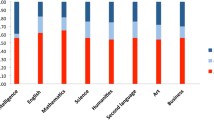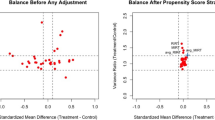Abstract
Maximum likelihood methods are presented to test for the relations between causes and effects in linear path diagrams, without assuming that estimates of causes are free of error. Causal analysis is illustrated by published data of the Equal Educational Opportunity Survey, which show that American schools do not significantly modify socioeconomic differences in academic performance and that little of the observed racial difference in academic performance is causal. For two races differing by 15 IQ points, the differential if social class were randomized would be only about 3 points. The principle is stressed that a racial effect in a causal system may be environmental and that its etiology can be studied only by analysis of family resemblance in hybrid populations.
Similar content being viewed by others
References
Bartlett, M. S. (1954). A note on the multiplying factors for various χ2 approximations.J. Roy. Stat. Soc. Ser. B 16:296–298.
Beaton, A. E. (1969). Scaling criterion of questionnaire items.Socio-Econ. Plan. Sci. 2:355–362.
Blalock, H. M. (1964).Causal Inference in Non-experimental Research, University of North Carolina, Chapel Hill, N.C.
Elston, R. C. (1975). On the correlation between correlations.Biometrika (in press).
Fisher, R. A. (1921). On the probable error of a coefficient of correlation deduced from a small sample.Metron 1:1–32.
Goldberger, A. S. (1972). Structural equation methods in the social sciences.Econometrica 40:979–1001.
Goldberger, A. S., and Duncan, O. D. (1973).Structural Equation Models in the Social Sciences, Seminar Press, New York.
Haldane, J. B. S. (1964), A defense of beanbag genetics.Perspect. Biol. Med. 7:353.
Hotelling, H. (1953). New light on the correlation coefficient and its transforms.J. Roy. Stat. Soc. Ser. B 15:193–232.
Jöreskog, K. G. (1973). A general method for estimating a linear structural equation. In Goldberger, A. S., and Duncan, O. D. (eds.),Structural Equation Models in the Social Sciences, Seminar Press, New York, pp. 85–112.
Kullback, S. (1959).Information Theory and Statistics, Dover, New York.
Mayeske, G. W. (1969). The development of a model for student achievement.Socio-Econ. Plan. Sci. 2:363–371.
Mayeske, G. W., Cohen, W. M., Wisler, C. E., Okada, T., Beaton, A. E., Jr., Proshek, J. M., Weinfeld, F. D. and Tabler, K. A. (1972)A Study of Our Nation's Schools, DHEW Publication No. (OE) 72–142, Government Printing Office, Washington, D.C.
Morton, N. E., Stout, W. T., and Fischer, C. (1976). Academic performance in Hawaii,Soc. Biol. 23:13–20.
Nichols, P. L., and Anderson, V. E. (1973). Intellectual performance, race and socioeconomic status.Soc. Biol. 20:367–374.
Popper, K. R. (1961),The Logic of Scientific Discovery, Science Editions, New York.
Rao, D. C., Morton, N. E., and Yee, S. (1974). Analysis of family resemblance. II. A linear model for familial correlation.Am. J. Hum. Genet. 26:331–359.
Rao, D. C., MacLean, C. J., Morton, N. E., and Yee, S. (1975). Analysis of family resemblance. V. Height and weight in northeastern Brazil.Am. J. Hum. Genet. 27:509–520.
Shuey, A. M. (1966).The Testing of Negro Intelligence, Social Science Press, New York.
Susser, M. (1973)Causal Thinking in the Health Sciences: Concepts and Strategies of Epidemiology, Oxford University Press, New York.
Wright, S. (1931). Statistical methods in biology.J. Am. Stat. Assoc. Suppl. 26:155–163.
Author information
Authors and Affiliations
Additional information
PGL Paper No. 155. This work was supported by Grants GM 17173, 1-K3-GM-31, 732, GM HD16697, and HD06003 from the National Institutes of Health.
Rights and permissions
About this article
Cite this article
Rao, D.C., Morton, N.E., Elston, R.C. et al. Causal analysis of academic performance. Behav Genet 7, 147–159 (1977). https://doi.org/10.1007/BF01066003
Received:
Accepted:
Issue Date:
DOI: https://doi.org/10.1007/BF01066003




